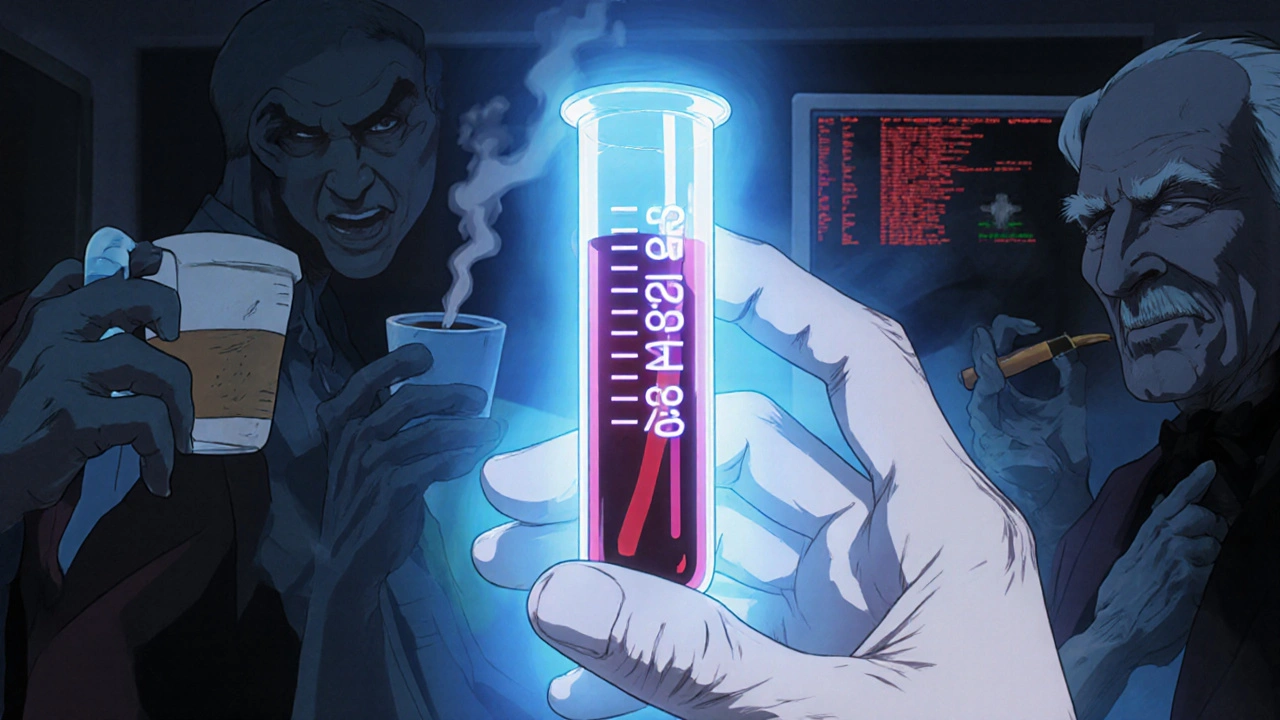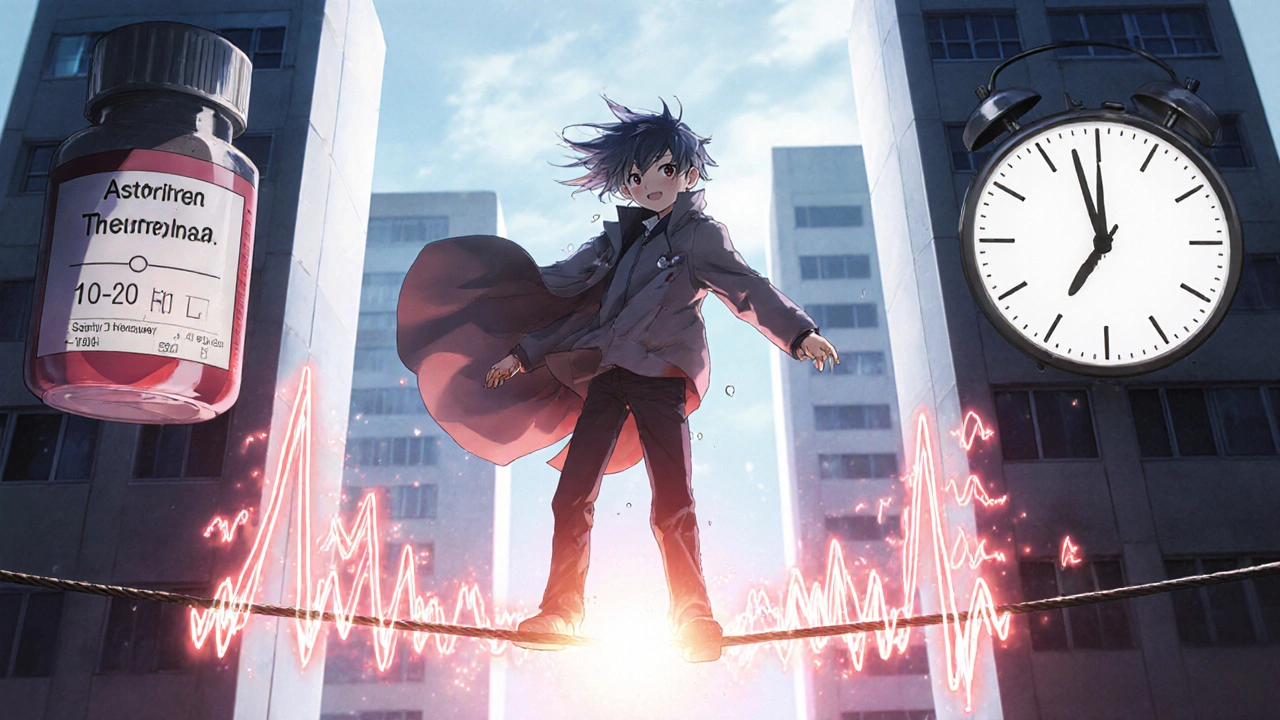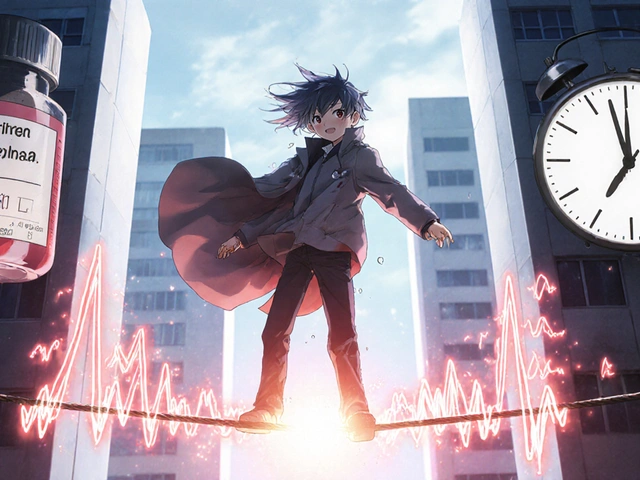When you take theophylline for asthma or COPD, you’re not just swallowing a pill-you’re walking a tightrope. One milligram too much, and your heart could start racing. One milligram too little, and your lungs won’t get the relief they need. That’s because theophylline has a narrow therapeutic index-a tiny window between working and causing harm. For most drugs, there’s room for error. For theophylline, there isn’t. That’s why monitoring your blood levels isn’t optional. It’s life-saving.
What Makes Theophylline So Dangerous?
Theophylline has been used since the 1930s to open airways in people with severe asthma and COPD. It works by relaxing smooth muscle in the lungs and reducing inflammation. But here’s the catch: the difference between a therapeutic dose and a toxic one is razor-thin. Doctors aim for blood levels between 10 and 20 mg/L. Below 10 mg/L? The drug barely works. Above 20 mg/L? You’re at risk for seizures, irregular heartbeats, vomiting, and even death.
What makes this worse is how unpredictable the drug is. Two people can take the exact same dose-one might stay safe, the other could end up in the ER. Why? Because theophylline is broken down by your liver, and that process varies wildly from person to person. If you smoke, your body clears it faster. If you’re over 60, have heart failure, or liver disease, it lingers longer. Even something as simple as switching from coffee to tea can change how your body handles it.
Drug Interactions Can Turn a Safe Dose Into a Poison
You might not realize it, but the antibiotics you take for a sinus infection, the heartburn medicine you use daily, or even St. John’s Wort for low mood can drastically alter your theophylline levels. Erythromycin, clarithromycin, ciprofloxacin, and cimetidine can spike your levels by 50% to 100%. That’s not a small change-it’s the difference between control and crisis.
On the flip side, drugs like carbamazepine, rifampicin, or even smoking can slash your levels by 30% to 60%. A patient who’s been stable on 400 mg a day for months might suddenly stop smoking. Their body starts holding onto the drug. Within days, their levels climb into the toxic range. Without a blood test, no one knows why they’re feeling shaky, nauseous, or having palpitations.
A 2023 case in Cureus showed a 68-year-old man with COPD who developed ventricular tachycardia after starting ciprofloxacin. His theophylline level jumped from 14 mg/L to 28 mg/L in just 72 hours. He survived-but only because his doctor ordered a blood test. Many aren’t so lucky.
When and How Often Should You Get Tested?
Monitoring isn’t a one-time thing. It’s a rhythm. When you start theophylline, you need your first blood test after 5 days-long enough for the drug to build up in your system. After a dose change, wait 3 days. Then, if you’re stable, check every 6 to 12 months.
But if you’re in a high-risk group, you need more frequent checks:
- Over 60? Test every 3 to 6 months.
- Heart failure or liver disease? Every 1 to 3 months.
- Pregnant? Monthly during the second and third trimesters.
- Started a new medication? Test within a week.
- Stopped smoking or changed alcohol intake? Test immediately.
Timing matters too. For immediate-release tablets, blood should be drawn right before your next dose-the lowest point, called the trough. For extended-release forms, test 4 to 6 hours after taking it. Get it wrong, and the result is meaningless.

It’s Not Just About the Number
A blood level tells you part of the story. But you also need to watch your body. Are you feeling restless? Having headaches? Heart racing? These aren’t just side effects-they’re red flags. A heart rate over 100 beats per minute, tremors, or confusion could mean your level is climbing into danger.
Doctors also check your potassium. Theophylline often comes with other drugs-like albuterol or steroids-that can drain potassium. Low potassium makes arrhythmias more likely. A full blood count is sometimes needed too, since theophylline can, rarely, suppress bone marrow.
If you’re getting the drug through an IV, the line must be monitored closely. Mixing it with dextrose can cause clumping or damage to your veins. This isn’t theoretical-it’s happened in hospitals.
Real Results: Monitoring Saves Lives
One hospital in the U.S. tracked theophylline use for 18 months after implementing a strict monitoring protocol. They saw a 78% drop in adverse events. Asthma control improved by 35%. Patients who were once in and out of the ER started living normally.
On the flip side, the NHS found that 15% of theophylline-related emergencies happen because doctors didn’t adjust the dose for liver problems. Another 22% come from unmonitored antibiotic interactions. These aren’t rare mistakes-they’re preventable.
Patients themselves notice the difference. In surveys, 82% of long-term users say their symptoms are better controlled when levels are in range. Even though 68% call blood tests annoying, nearly all agree it’s worth it.

Why Keep Using It When There Are Better Options?
Yes, newer inhalers and biologics exist. They’re safer. They’re easier. But they’re also expensive-up to $400 a month. Theophylline? Generic versions cost $15 to $30. In places without good insurance or access to specialty drugs, it’s still a lifeline.
And it’s not just about cost. For some people with severe asthma, theophylline’s anti-inflammatory effect-restoring HDAC2 activity in lung cells-is unique. No other drug does exactly this. So even as newer treatments rise, theophylline hasn’t disappeared. It’s just become more carefully managed.
What’s Next for Monitoring?
Right now, you need a lab, a needle, and a few days to get results. But that’s changing. Three companies are testing handheld devices that can measure theophylline levels in under five minutes using a drop of blood. Think of it like a glucose monitor for asthma.
Until those tools are approved and widely available, the standard hasn’t changed: serum level testing is still the gold standard. The American College of Chest Physicians says so clearly. No shortcuts. No assumptions. No guessing.
And here’s the hard truth: the number of theophylline poisonings is rising. In the U.S., cases reported to poison control centers went up 23% between 2020 and 2023. Most involved elderly patients with undiagnosed kidney or liver issues. They weren’t being monitored. They didn’t know they were at risk.
Theophylline isn’t a drug you can take and forget. It demands attention. It needs tests. It requires communication between patient and provider. But when done right, it works. It opens airways. It prevents hospitalizations. It gives people back their breath.
That’s why monitoring isn’t just medical practice. It’s respect-for the drug, for the body, and for life itself.
How often should theophylline levels be checked?
Initial testing should happen 5 days after starting treatment or 3 days after a dose change. For stable patients, check every 6 to 12 months. High-risk groups-like those over 60, with heart or liver disease, or pregnant-need testing every 1 to 3 months. Always test after starting or stopping other medications, changing smoking habits, or if you develop symptoms like nausea, tremors, or palpitations.
What is the safe range for theophylline blood levels?
The accepted therapeutic range is 10 to 20 mg/L (or μg/mL). Some patients may respond well at lower levels (5-15 mg/L), especially if they’re elderly or have side effects. Levels above 20 mg/L increase toxicity risk, and above 25 mg/L can cause life-threatening seizures or heart rhythm problems. Always treat levels above 20 mg/L as urgent.
Can I stop taking theophylline if I feel fine?
No. Feeling fine doesn’t mean your levels are safe. Theophylline has no immediate symptoms at toxic levels until it’s too late. Stopping without medical advice can cause your asthma or COPD to flare up. Never adjust or stop your dose on your own-even if you think you don’t need it anymore. Always talk to your doctor and get a blood test first.
Do I need to avoid caffeine with theophylline?
Caffeine is chemically similar to theophylline and can add to its effects. While moderate coffee intake (1-2 cups a day) is usually fine, large amounts can increase side effects like jitteriness, rapid heartbeat, or insomnia. If you’re sensitive to caffeine or notice symptoms worsening, reduce intake. Tell your doctor about your daily caffeine habits-it affects how they interpret your blood levels.
Why is theophylline still used if it’s so risky?
It’s still used because it works-especially for severe asthma and COPD that don’t respond to inhalers. It has unique anti-inflammatory effects that newer drugs don’t fully replicate. Plus, it’s cheap. In places without access to expensive biologics, it’s a vital option. The risk isn’t ignored-it’s managed. With proper monitoring, the benefits outweigh the dangers for many patients.
What should I do if I miss a dose of theophylline?
If you miss a dose, take it as soon as you remember-but only if it’s within a few hours of the scheduled time. Don’t double up. Missing doses can cause your levels to drop below therapeutic range, leading to worsening symptoms. If you miss more than one dose, contact your doctor. They may want to check your blood level before advising you to restart. Never guess your way back into a safe range.
Can I get theophylline levels tested at my local pharmacy?
Currently, no. Theophylline level testing requires specialized lab equipment and is not available at pharmacies or with home test kits. Blood must be drawn and sent to a clinical laboratory. Some point-of-care devices are in development and undergoing trials, but none are approved for routine use yet. Until then, plan ahead for clinic visits or lab appointments.








Jennifer Shannon
November 23, 2025 AT 10:15Theophylline is one of those drugs that feels like it was invented by someone who believed in the poetic justice of medicine-too close to the edge to be safe, but just right enough to save lives if you’re careful enough. I’ve seen grandmas on it, smokers on it, people who’ve been on it since the 90s, and somehow, they’re still breathing. It’s not glamorous, but it’s real. And honestly? In a world where everything costs $500 a month and comes with a 12-page consent form, theophylline is the quiet rebel that still works-and it doesn’t ask for anything but your attention.
It’s like driving a manual car in an automatic world. You’ve got to pay attention. Shift gears. Watch the RPM. But when you get it right? There’s a rhythm. A connection. You feel the road. You feel the medicine. And yeah, if you miss a shift, things get ugly. But that’s not the drug’s fault. That’s us forgetting to listen.
I remember my aunt-72, COPD, never smoked, lived on the edge of a cliff with this stuff. She’d get her levels checked like clockwork. Even when she felt fine. Even when the pharmacy guy said, ‘You’re fine, ma’am, you’ve been on this forever.’ She’d say, ‘Fine isn’t the goal. Alive is.’ And she was right. She’s still here. Because she respected the tightrope.
And the caffeine thing? Oh, please. I used to drink three espressos a day and wonder why I was jittery. Turns out, my body was doing a theophylline-and-coffee tango. One cup a day now. No more. No drama. Just peace. And my lungs thank me.
It’s not about fear. It’s about fidelity. To your body. To your doctor. To the fact that some medicines aren’t meant to be set-and-forget. They’re meant to be danced with. Slowly. Carefully. With respect.
And if you think it’s outdated? Look at the cost. Look at the access. Look at the people who don’t have biologics, don’t have insurance, don’t have options. Theophylline isn’t nostalgia. It’s necessity. And the fact that we’re still talking about it? That’s a good thing.
Let’s not romanticize it. Let’s not fear it. Let’s just… honor it. With tests. With conversations. With the quiet discipline of showing up for your own breath.
And if you’re on it? Keep going. Just don’t forget to check. That’s all. Just check.
Dalton Adams
November 23, 2025 AT 18:36Let’s be clear: theophylline isn’t ‘dangerous’-it’s misunderstood. And anyone who calls it ‘archaic’ hasn’t read the pharmacokinetic literature. The half-life variability? That’s not a flaw-it’s a feature of human metabolic diversity. CYP1A2 polymorphisms, smoking-induced enzyme induction, hepatic clearance gradients-these aren’t bugs, they’re biological reality.
And yes, ciprofloxacin increases levels by 50–100%? That’s not ‘dangerous’-it’s predictable. The AUC increases due to CYP1A2 inhibition. You don’t need to ‘guess’-you need to calculate. The nomograms are published. The guidelines are clear. If your doctor doesn’t know this, they shouldn’t be prescribing it.
And don’t get me started on ‘point-of-care devices.’ We’ve had portable GC-MS for decades. The real barrier isn’t tech-it’s reimbursement. Hospitals won’t pay for theophylline monitoring because they’d rather admit you for ventricular tachycardia than invest in a $200 lab test. That’s not medicine. That’s capitalism.
Also, caffeine? It’s a competitive inhibitor. Same receptor. Same pathway. But you don’t need to ‘avoid’ it-you need to quantify it. 200mg caffeine = ~10% increase in theophylline AUC. That’s not a crisis. That’s a data point. Track it. Log it. Adjust.
And for the love of pharmacology, stop calling it ‘risky.’ Everything’s risky. Insulin? Risky. Warfarin? Risky. Theophylline? Just… more math. Do the math. You’ll be fine.
Kane Ren
November 25, 2025 AT 18:27This post gave me chills. Seriously. I’ve watched my dad go from gasping for air to walking the dog again-just because he got his levels checked after his antibiotics changed. He didn’t even know he was in danger. I’m so glad he listened. If you’re on this med, don’t wait until you feel bad. Get tested. Even if you think you’re fine. You’re not just protecting your lungs-you’re protecting your future.
It’s not just about the numbers. It’s about breathing easy. And that’s worth every needle prick.
John Mackaill
November 27, 2025 AT 03:46I’ve worked in respiratory clinics for 18 years, and theophylline is one of those drugs that teaches humility. It doesn’t care if you’re young or old, rich or poor. It just reacts. And if you treat it like a normal pill, it’ll bite back.
I’ve seen patients who stopped smoking and didn’t tell their doctor-then ended up in ICU. I’ve seen elderly folks on multiple meds, and no one checked interactions. It’s not negligence-it’s oversight. And it’s preventable.
But here’s what I’ve learned: when patients are educated, when they’re involved, when they know why the blood test matters-they don’t resent it. They own it. And that’s the real win. Not the numbers. The partnership.
So if you’re reading this and you’re on theophylline? Ask your doctor: ‘What’s my level? When’s the next one? What should I watch for?’ You’re not being difficult. You’re being smart.
Casper van Hoof
November 27, 2025 AT 17:38Theophylline, as a methylxanthine derivative, exerts its bronchodilatory effects primarily via non-selective phosphodiesterase inhibition and adenosine receptor antagonism. Its narrow therapeutic index is a direct consequence of its low therapeutic index relative to its toxicological threshold, which is approximately 1.5–2.0-fold above the therapeutic range. The pharmacokinetic variability observed across populations is attributable to polymorphisms in the CYP1A2 enzyme, which is responsible for approximately 90% of its hepatic metabolism. Consequently, factors such as smoking (inducer), age-related decline in hepatic clearance, and concomitant administration of CYP1A2 inhibitors (e.g., fluoroquinolones) result in clinically significant alterations in plasma concentration. The American College of Chest Physicians, in its 2021 clinical guidelines, explicitly recommends therapeutic drug monitoring as a Class I recommendation for all patients initiated on theophylline therapy, irrespective of age or comorbidity status. The rising incidence of toxicity in geriatric populations is not a failure of the drug, but a failure of clinical vigilance. To dismiss theophylline as outdated is to misunderstand the principle of therapeutic equity: access to effective, affordable therapy remains a moral imperative in resource-constrained systems. Monitoring is not an inconvenience-it is the ethical baseline of pharmacotherapy.
Richard Wöhrl
November 28, 2025 AT 04:07Let me tell you something I’ve seen too many times: a patient comes in, says, ‘I feel fine,’ and their theophylline level is 27. They’re not dizzy, not nauseous, not shaking-but their EKG is a mess. That’s the silent danger. The body doesn’t always scream before it collapses.
And here’s the thing-most people don’t know how many things affect this drug. Not just antibiotics. Not just smoking. Coffee? Yes. Grapefruit juice? Oh, absolutely. Even a change in diet-like switching from high-protein to high-carb-can shift your liver’s ability to break it down.
And don’t forget potassium. If you’re on albuterol or steroids, you’re losing potassium. Low potassium + high theophylline = recipe for cardiac chaos. I’ve had patients who didn’t even know they were on potassium supplements because their doctor never mentioned it.
And the timing of the blood draw? So many people get it wrong. Trough level? Before your next dose. Not after. Not random. Before. If you get it drawn at the wrong time, you’re flying blind.
And yes, it’s annoying. Yes, it’s inconvenient. But if you’re still breathing because of this drug, isn’t that one extra trip to the lab worth it?
I’ve had patients tell me, ‘I’m not doing it anymore.’ I’ve had others say, ‘I’ll do it every time.’ The ones who do? They live longer. They’re calmer. They sleep better. The ones who don’t? They end up back in the ER. Or worse.
So if you’re on theophylline-don’t just take the pill. Take the test. It’s not just medicine. It’s your lifeline.
Pramod Kumar
November 30, 2025 AT 02:23Bro, theophylline is like that old bike you still ride-rusted in places, squeaky when you turn, but it gets you where you need to go. No fancy gears, no GPS, no app to track your ride. Just you, the road, and a little bit of faith.
I’ve seen it in India-grandmas on it, no insurance, no fancy inhalers, just a tiny blue pill and a blood test every three months. And you know what? They’re alive. They’re laughing. They’re cooking. They’re breathing.
It’s not about being modern. It’s about being smart. If your doctor says, ‘Check your levels,’ don’t say ‘I’m fine.’ Say, ‘How much does it cost?’ Then say, ‘Do it.’
And caffeine? Yeah, I know. You love your chai. But maybe skip the third cup. Your heart will thank you. And your lungs? They’ll give you a high-five.
This drug? It’s not magic. But it’s honest. It doesn’t lie. If you ignore it, it’ll remind you. Loudly. So don’t ignore it. Just check. Just once. Just to be safe.
Because breath? It’s the only thing you can’t buy. Not even with money.
Brandy Walley
November 30, 2025 AT 14:15shreyas yashas
December 1, 2025 AT 00:06My uncle was on theophylline. He didn’t believe in blood tests. Thought it was ‘overkill.’ Then he got pneumonia, started on azithromycin, and woke up in the hospital with his heart racing like a drum. They said if they hadn’t checked his levels, he wouldn’t have made it.
He cried when he found out how close he came. Said he’d never skip a test again.
So if you’re reading this and you’re on this med? Don’t be like him. Don’t wait for the scare. Just check. Just once. For your breath. For your family. For yourself.
It’s not a burden. It’s a gift.